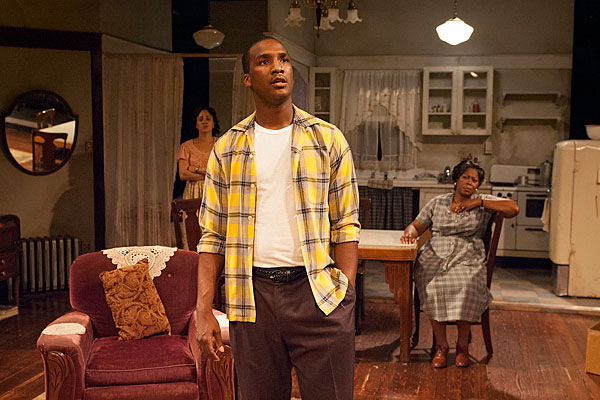
Photo: Lara Goetsch
Walter Lee Younger (Jerod Haynes, center) dreams of a better life for his wife, Ruth (Toni Martin, left), and mother, Lena (Greta Oglesby), in TimeLine Theatre’s production of Lorraine Hansberry’s A Raisin in the Sun.
Last week, on the same day that much of the country paused to measure the distance we’ve come in the fifty years since Dr. Martin Luther King, Jr’s “I Have A Dream” speech, a Chicago theatre company opened a new production of A Raisin in the Sun, the groundbreaking play from a few years before King’s speech. The show makes you think about how much the housing status of Chicago’s African-Americans has changed—or hasn't—since that era.
The TimeLine Theatre Co. production places the audience right inside an over-crowded apartment with roaches under the couch and a shared bathroom in the hall. And a troupe of powerful actors gained praise from the Tribune’s theater reviewer, Chris Jones, for offering up what he described as an “Immersive, intimate, visceral, local, emotional, superbly acted production.”
I’m not Chicago’s theatre critic, but I loved the production. Both the performers and the almost claustrophobic set made it feel more “immersive” than a 50th anniversary production that I saw a few years back on the stage of the former Blackstone Theater, the very stage where Lorraine Hansberry’s script debuted in 1959 before going to Broadway.
Hansberry borrowed the title of her play from Langston Hughes’s poem A Dream Deferred—a title that could also describe the effect of the housing boom and bust on many of Chicago’s predominantly African-American neighborhoods. If in the Raisin era African-Americans saw their dreams of better living circumstances deferred by racist attitudes that kept them out of certain neighborhoods, now many are struggling with the aftermath of the wreckage that foreclosure brought to their neighborhoods.
Sixteen Chicago community areas that are majority African-American had ten percent or more of their homes foreclosed between 2008 and 2012, according to Spencer Cowan, vice president of the Woodstock Institute. There were also two Latino-majority and two white-majority neighborhoods where that was true. (That’s 20 out of Chicago’s 77 community areas.)
“How do you rebuild a community where ten percent of the properties have been in foreclosure?” Cowan asked Tuesday. “This is devastating.” After starting out with less property wealth, and assets, historically, than the general population, African-American homeowners in these neighborhoods have then lost more of what they had than others did. And as the foreclosures sit empty, they stand to keep losing more.
As we discussed the morning of the “Dream” speech anniversary on WBEZ’s “The Morning Shift,” many African-American homeowners were the first in their families to own, and whether they later lost their own home or saw their neighborhood stumble under the weight of their neighbors’ losses, the cost has been psychological as well as financial. A Bloomberg News story noted yesterday that the nationwide black homeownership rate fell by seven percentage points after the bust. In Chicago’s Roseland neighborhood, the article points out, far steeper than the rate of homeownership has been the drop in home value: nearly 77 percent between 2005 and mid-2013.
Hansberry’s play ends with the members of the Younger family resolved to get out of the decaying neighborhood they’re in, and move to a white neighborhood even though they already know they’re not wanted there. Nobody’s quite sure what will happen next.
And the same is true now. Cowan notes that the investors who have bought thousands of foreclosed homes in the city’s lower-income neighborhoods will, for the most part, turn out to be either of two types.
One type will be looking for short-term return on their investment, so they’ll put as little new money as possible into the properties they buy, and unload them a few years later when rental income has paid off their investment. “They’ll walk away and let the property deteriorate further,” he says.
The other type will have long-term goals that involve improvement of both the property and the neighborhood around it. They’ll accept lower profit margins and a deferred payoff. “You hope more of them will be this group,” Cowan says, but there’s no way to tell until a few years down the line.
So for the moment, hold your applause.


